Migration Update – East Africa
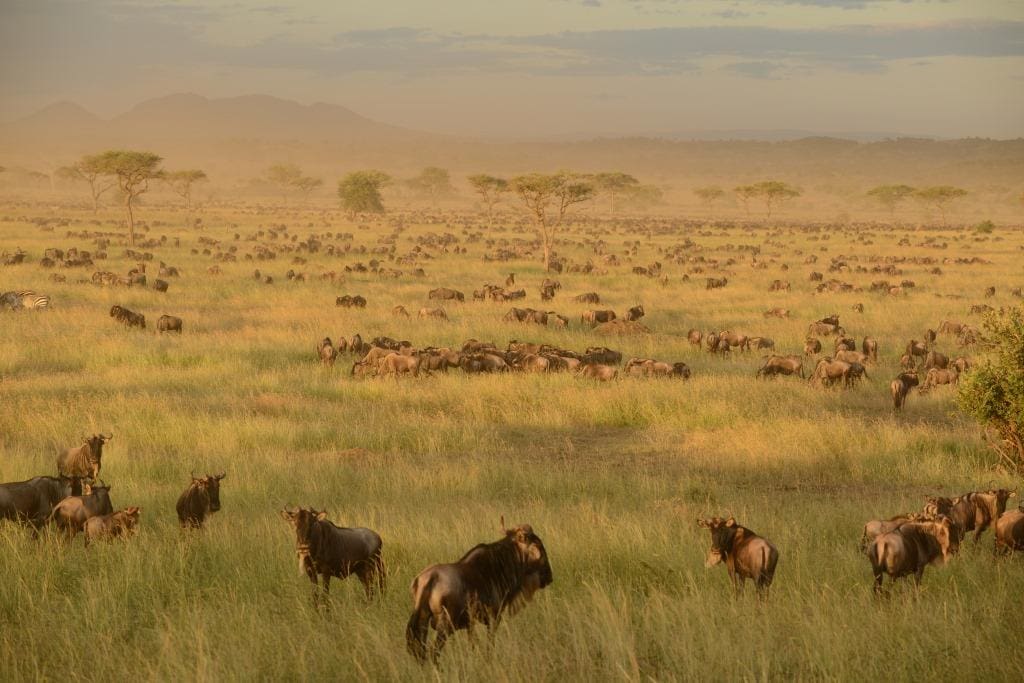
What is The Great Migration?
The Great Migration is the largest herd movement of animals on the planet. In fact, with up to 1,000 animals per km², the great columns of wildebeest can be seen from space. The numbers are astonishing: over 1.2 million wildebeest and 300,000 zebra, along with topi and other gazelle, move in a constant cycle through the Serengeti-Mara ecosystem in search of nutritious grass and water. Guided by survival instinct, each wildebeest will cover 800 to 1,000km on its journey along age-old migration routes. Hungry predators, including lion, leopard, cheetah, hyena, wild dog and crocs make sure only the strongest survive in this natural spectacle also known as ‘the greatest show on Earth.’
When and where does the Migration take place?
You can witness the Great Migration at any time of year, as it is a constant movement of the herds.
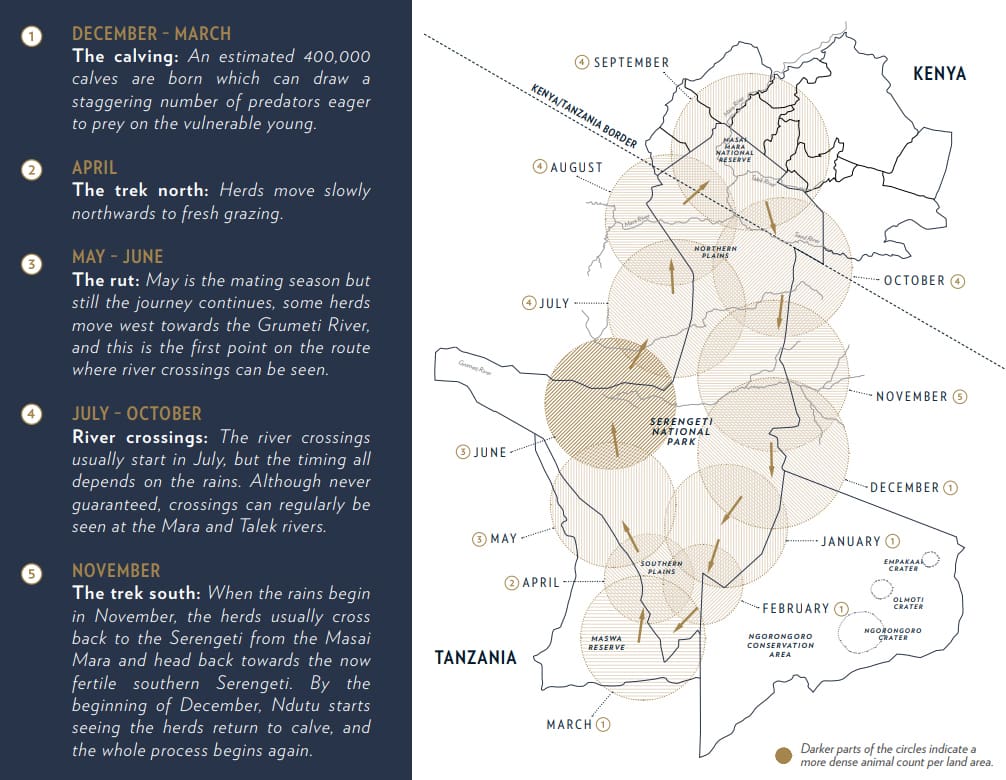
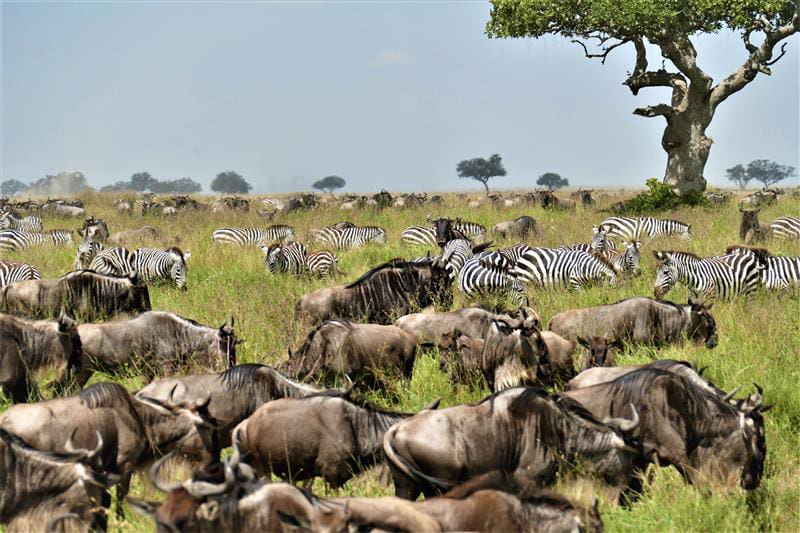
In the central Serengeti, the herds are spreading across the Moru Kopjes and Simba Kopjes, while some are already moving toward the eastern Serengeti. The grass is lush across these areas, and the wildebeest are eagerly grazing as they continue their northward journey in search of even more pasture and food.
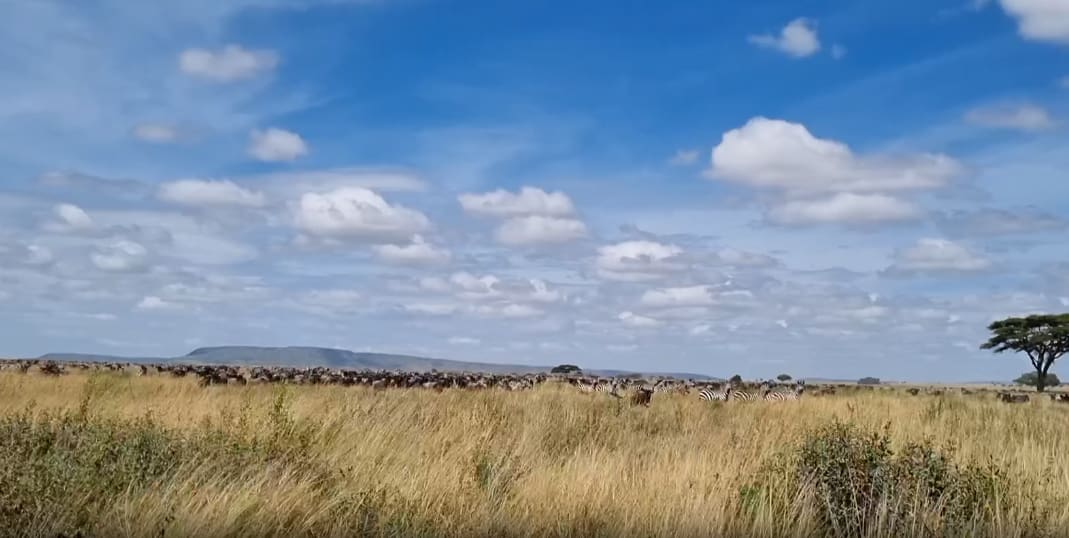
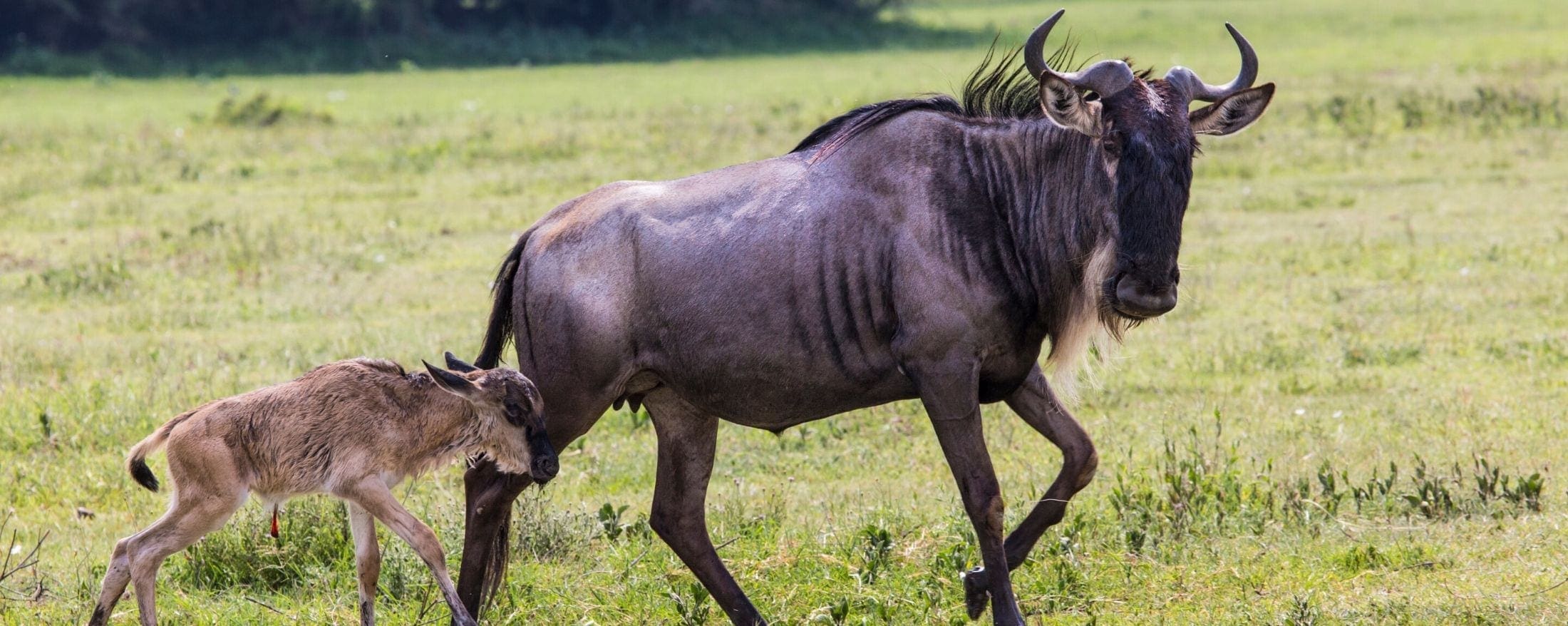
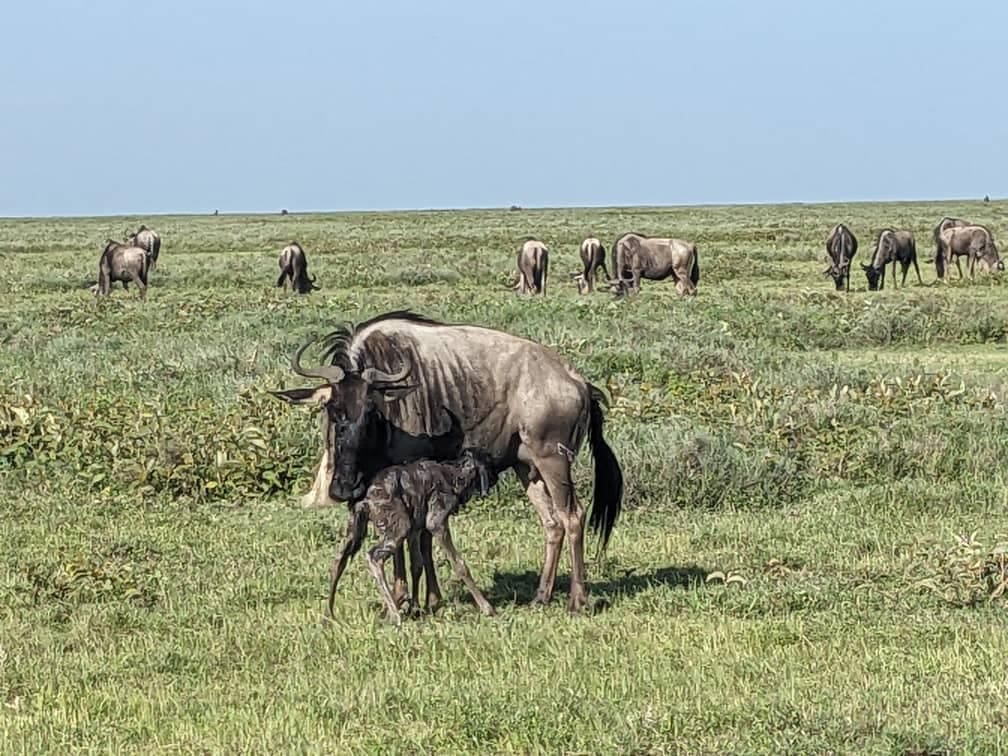
The wildebeest migration is currently taking place in the southern Serengeti, Tanzania, with a concentration around the Ndutu region. This is where the calving season is underway, with thousands of wildebeest calves being born. The herds are spread across the short-grass plains, grazing and tending to their newborns.

If herds of wildebeest and zebra migrate and no tourists are around to see them, is the Great Migration going on?
The answer is absolutely yes! About 2 weeks ago, the first of the great wildebeest and zebra herds began to arrive in the Grumeti Reserve. Their arrival coincides with the end of the rains and the transformation of the grasslands from a green to a beautiful, golden-yellow color.
The Migration Movement updated – April 01, 2020
The resident Loita wildebeest are spread out in the northeast conservancies, but no longer extend to the Loita Hills. The grass levels are high enough in the northeast conservancies young calves to eat.
There are no signs of the Serengeti wildebeest yet (still early days). They are more than likely still moving through the Serengeti, Naabi Hill and Maswa areas. The entire ecosystem has been regenerated to quite an extent due to heavy rainfalls from November 2019 until mid-February 2020.
The Migration Movement updated – January 28, 2020 – It’s January, so that means it’s calving season. From around January to February, millions of wildebeest and zebra congregate in the Southern Serengeti to give birth to countless foals and calves. It’s estimated that during these months more than 8000 wildebeests are born per day.
In contrast, feline cubs are now old enough to begin learning how to hunt. For example, once cheetah cubs reach around 8 months old, their mother will start releasing some of the prey she catches so the cubs can learn to kill prey on their own. They have less than a year to learn before they’re forced to fend for themselves!
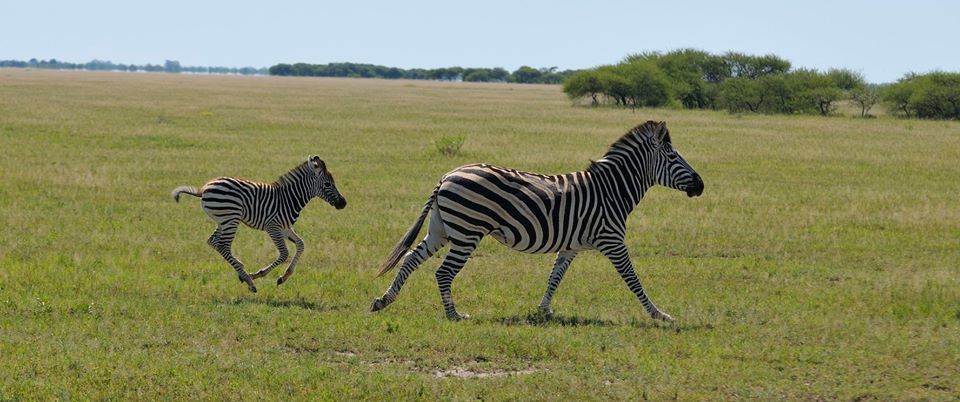
![]()
2019 Migration Movement updated
The Migration Movement updated – October 11, 2019 – The month of October is much like the preceding month: herds will cross from one side of the Mara and Sand Rivers only to recross not too long thereafter. But what differentiates October from September is that this trend gradually transforms into a more consistent southward movement; multiple guides have reported more and more herds continuing southward into the Serengeti. This seems to be partly stimulated by early rains in the Northern Serengeti. But river crossings as a whole should not end yet, as there is still some edible grass in the Mara. Furthermore, the herds tend to move very slowly this time of year. These factors are big reasons why some herds will still linger in the Northern Serengeti and possibly even the Mara (under certain circumstances) until the end of the month.
The Migration Movement updated – September 5, 2019 – The herds are still spread out across the Northern section of the Serengeti pushing and shoving to cross the Mara River to get to the grasses on the Masai Mara side of the river. However, it is also quite common to see the herds cross the river to the north one day, only for them to undergo the terror and fright to cross to the south the next day.
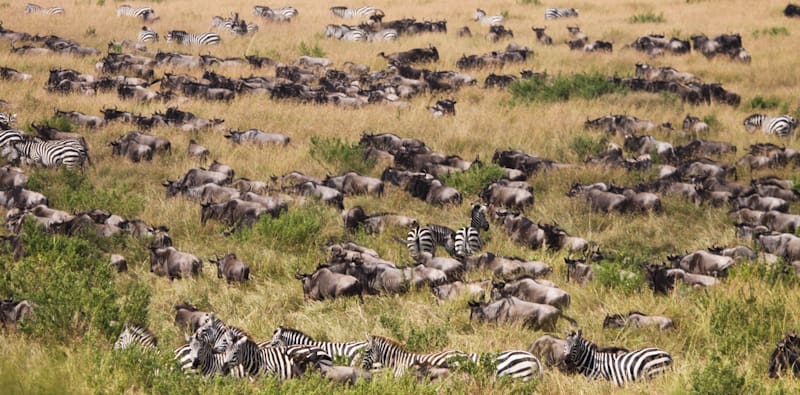
The Migration Movement updated – July 29, 2019 – Update from Governor’s Camp – Governor’s Camp guests witnessed a crossing right in front of the camp. The herds continue their search for lush, greener grass by crossing the dangerous, crocodile-infested water of the Mara River. Safari guide Micheal Thomas captured a major crossing during his morning game drive at Crossing Point number 4.
Update from Asilia Africa – Action in the Mara River! Safari guide Emmanuel Qamara captured thousands of wildebeest crossing the Mara River from the Southern to the Northern Serengeti, while a lioness tried her luck at going in for a kill.
The Migration Movement updated – June 28, 2019 – There have been multiple reports so far this month of wildebeest crossing over the Mara River en masse from the northern Serengeti and into lush, verdant grasslands of the Maasai Mara. This is unusually early for this awe-inducing phenomenon! Typically, the Great Migration is still between the Grumeti and Mara Rivers in the Serengeti. They must have made record pace, as this is the time of year when the wildebeest herds reach their peak pace.
This is just another friendly reminder that predicting the location of the Great Migration is no exact science; it’s nature, after all!
The Migration Movement updated – April 29, 2019 – Like past years, there is still enough nutritious grass & rain to encourage some wildebeest and zebra herds to remain in the southern plains. But we are starting to see the beginning of a “big push” by these herds towards the dry season grazing grounds of the northern Serengeti and the Maasai Mara. Though the exact migratory course is impossible to predict, its exciting to see these herds, including the new-born calves, on the move again!
The Migration Movement updated – March 26, 2019 – February/March are the Easiest Month to Predict Where the Migration Will Be in the Serengeti
February/March is calving season – a period when wildebeest, zebra, and other migratory animals give birth to their offspring. Once the calves are born, the herds don’t move much. The chance of witnessing a wildebeest birth is high. Predator interaction is also very likely, as lion and leopard move into the region to prey on young and vulnerable calves.

Where to stay in February/March – The migration has been in and around Lakes Ndutu and Masek for the last 10 or 12 years. It might have varied by 10 miles, but without fail the wildebeest herds gather between Matiti Hill, Ndutu, Naabi Hill, the Gol kopjes to the east and Olduvai Gorge. During the calving season, these areas in southern plains are teaming with wildebeest as hundreds of thousands of pregnant females converge to give birth allowing you to see live wildebeest and zebra calving.
The Migration Movement updated – February 19, 2019 – The calving season is in full swing in the Ngorongoro Conservation Area! The great herds were seen on the Kusini Plains heading towards the woodlands in the southern end of the ecosystem. The guides spotted about 50 newly-borns and over the next few months, 500,000 calves will begin their life in the Serengeti. Bobby-Jo Photography captured an intense cheetah hunt on the Ndutu Plains. The young male caught a newborn wildebeest calf – it was quite confronting as the young calf struggled for its life. Very emotional morning, but nature as it is!
Be prepared for some heart-ache as the predators move quickly onto the newborn calves for their annual feast. Mother Nature is revealing what the circle of life means in full gore and vigour. With the promise of short rains, the young wildebeest and zebras are almost guaranteed fresh and constant grass all the way into the central parts of the Serengeti. With thousands of these baby wildebeest running around it is much easier for a mother lion, cheetah or leopard to find a meal for their hungry cubs as well as give them the opportunity to learn how to hunt for themselves by practicing on young calves before they have to go out and fend for themselves! Young cubs learn valuable lessons during this time which is crucial to their success.
The Migration Movement updated – December 10, 2018 – The New Year heralds spectacular storms, a time of new life on the plains, adorable offspring, ample and dynamic with its own distinct rhythm. The wondrous sensation of the wildebeest-birthing season, young cubs, curious playful moments, grand skies lofty and lording, reign over all. Emotional and potent, January to February tends to be the focal point for the calving. Travel in March or April, and you’ll have the best of the secret season, carpeted with flowers, chock full of vigorous predators, overflowing with teeming herds and it’s all yours – no one else about. (Thank you to Serian Camps)
The Migration Movement updated – October 02, 2018 – October is normally a good time to see the wildebeest herds move back into the Serengeti. However, this year, the herds returned early to the Serengeti due to unseasonal rains in the Maasai Mara, Kenya. Safari guide Elia Edward captured a huge crossing of the wildebeest at point number 6 in the Mara River, Northern Serengeti.
The Migration Movement updated – September 05, 2018 – A recent report in from ranger Karim Saadun capturing a five-hour crossing in the Makutano crossing point on the Northern Serengeti plains. The short video really gives you the idea of the spectacular show!
The Migration Movement updated – August 26, 2018 – Jill Inman never imagined seeing not one, but four huge river crossings in the Northern Serengeti!

The Migration Movement updated – July 18, 2018 – The first smaller herds of wildebeest and zebra have crossed over into the Maasai Mara whilst the majority have made it to the Northern Serengeti gathering along the Mara river getting ready for the great crossing into the Maasai Mara. Rush hour is upon us and we can’t wait! Angama Mara photo credit.
The Migration Movement updated – June 26, 2018 – The first arrival of the wildebeest herds have been sighted at the Kirawira in the western Serengeti on their annual move to the north. However, some herds have taken the Togoro Plains towards the Lobo area route.
The Migration Movement updated – June 08, 2018 – “In the jungle, the mighty jungle, the lion sleeps tonight…”
The legendary lion, Bob, of the coalition Bob & Ziggy who spent part of his life in the “Namiri Plains” died a few days ago. This is heart-breaking news. This lion (assumed 15 years of age) was not only famous among our guides and guests but was legendary. We will all truly miss him ![]() 🐾
🐾
The Migration Movement updated – May 18, 2018 – The green grasses of Ndutu are enticing a few herds to turn around and head back plains of the Southern Serengeti. Meanwhile a large herd is moving slowly into the Central Serengeti through the Simba Kopjes and Gol Kopjes on their way to the northern Serengeti.

The Migration Movement updated – April 12, 2018 – The Grass is Greener…
It has been a super green season in Ndutu with the green grass drawing the migrating wildebeest back for grazing. The nutritious grassy plains are perfect for their calves, providing a plentiful supply of essential minerals needed for growing calves and lactating mothers. The wildebeest migration is now back in the plains of the Ndutu area. The herds are scattered all across the north-west of the Ndutu plains and the southern part of the Naabi Hill Gate.
The Migration Movement updated – March 1, 2018 – Large herds of resident wildebeest and zebra with their young calves and foals have arrived on the plains. The elephants continue to feed in large numbers in the Marsh and in the forests around our camps. There was great excitement at Governors Camp as an elephant gave birth in the early morning beside our plains tents! Marsh Pride lioness Rembo has returned to the Marsh, where she gave birth to three tiny cubs. She has kept the cubs safely hidden near the Marsh and we have enjoyed some wonderful sightings of them.
The Migration Movement updated – February 14, 2018 – Earlier this week, our drivers on safari have watched herds of wildebeest and zebra moving south towards the Naibadad Hill and towards the western side of Kusini. Reports from Monday & Tuesday this week inform that the migration is still on the move towards Kusini and a lot of baby calves are being born.
For many people, the thought of the Great Wildebeest Migration brings to mind images of thunderous river crossings with crocodiles snatching at the heels of wildebeest as they make their way across East Africa’s rivers.
Others may picture the seemingly never-ending line of millions of wildebeest on their great trek, however, the amazingness of the calving season is something that many people may overlook.
Calving usually takes place between January and February of each year. In January the herds begin making their way to the south of the Serengeti after the rains start falling. The question of how the herds know when it is raining or not is something many people have questioned and the answer is that we actually do not know! Many people say that they can smell the rain, others believe they can sense when the pressure in the air changes. The only thing we know for sure is that where it rains, the herds follow. Within a two to three week time period, over half a million wildebeest are born with as many as 8000 wildebeest being born on the same day!
The herds spend the majority of these three months in the Ndutu and Ngorongoro Conservation areas, although not within the crater itself. Many years ago, volcanoes in the area would erupt and the volcanic ashes that are left behind have led to the soil being rich in nutrients meaning that the grass that grows here is perfect for young wildebeest to munch on and build up their strength in the first few weeks of their lives.
With the promise of rains in the near future between February to May, the young wildebeest are almost always guaranteed fresh and constant grass all the way up into the central parts of the Serengeti.
It should come as no surprise that, with all of these baby zebra, gazelle and wildebeest stumbling around on their wobbly legs, the number of predators in the area reaches an all time high during this time of the year. However, an easy meal is no guarantee!
These mothers have been following this route for thousands of years and know most of the tricks that predators pull. Wildebeest mothers instinctively know to give birth on the shorter grass plains where approaching predators are easier to spot. Other mothers join them here and actually form protective barricades around the younger and most vulnerable new additions to the herd in order to ensure they have the greatest chance of survival.
Predators also have to deal with extremely over-protective mothers who will do everything in their power to protect their young so if you are travelling to the Serengeti during this time you are guaranteed to see some action unfolding between mothers, their calves and the hungry predators prowling the surrounding areas.
It is not only the older, more-experienced predators you will have the chance to see though, they too have co-ordinated their birthing times to coincide with the birth of their prey so that their young have the highest chance of survival too. With thousands of baby wildebeest running around it is much easier for a mother lion, cheetah or leopard to find a meal for their hungry cubs as well as give them the opportunity to learn how to hunt for themselves by practising on young calves before they have to go out and fend for themselves, young cubs learn valuable lessons during this time which is crucial to their success.
All of these factors go to show that the timing and location of the calving season was purposefully selected in order to increase the chances of survival, both for prey and predator alike. The calving season is truly a remarkable time in East Africa and has so much to offer any safari-goer looking to see something other than the usual river crossing.
![]()
2017 Migration Movement updated
The Migration Movement updated – December 18, 2017 – This year the migration had been very scattered, but far south (Serengeti) is where the migration is heading at the moment. Some of the herds might already be in the south whilst the others are still on the route. A huge group of the wildebeest was sighted moving between Moru and Naabi, heading towards Ndutu in the south. Meanwhile, another group was seen between the Matiti area and Kakesio region. Our friends at Kimondo Camp towards the southern tip of the Serengeti National Park send their holiday greetings, complete with a visiting wildebeest backdrop. The area had recently benefitted from three days of short rain storms. While the migration is unpredictable, it generally follows a clockwise route, with the movement of over one million wildebeest and hundreds of thousands of zebra heading south and east at this time of year to eventually give birth in the plains west of the Ngorongoro Crater in January and February. The massive herds then begin their months-long trek north and west to arrive in the Massai Mara National Reserve beginning in the middle of July and lasting into October. The Kimondo Camp is one of several seasonal camps which move locations twice a year for the best migration viewing. The camp is in the south from the beginning of December until the middle of March. From the beginning of July until the end of October, the camp is located in the northern Serengeti, nestled between the Mara River to the south and the Kenyan border to the north.
The Migration Movement updated – August 30, 2017 – The Grass is Always Greener on the Other Side – The crossings have begun. The Mara River is split up into different crossing points, all numbered, helping our guides and our Serengeti Nomad keep track of where the latest crossing is going on. A few weeks back the wildebeest were found crossing in large numbers at crossing points number 3 & 4, and more recently they are around crossing points 7 & 10. The migration is unpredictable and the wildebeest can make the crossing several times, moving back and forth between the Maasai Mara and Serengeti before they move on. With some short bursts of rain last week, the herds have been doing just that, and have made the crossing numerous times looking for the greener grazing spots.
The Migration Movement updated – July 06, 2017 – On the 28th of June, a huge herd crossed the river close to the Mara Bridge into the Masai Mara, one of the first river crossings sightings from Tanzania into Kenya! The Western Corridor & Ubuntu Camp is flooded with the Great Migration. Thousands of wildebeest are now grazing through the northern plains. The Great Migration is the largest overland migration in the world. The animals travel a total of approximately 600 miles during each cycle. While the migration may seem like a chaotic frenzy of movement bcause wildebeest have no natural leader, the migrating herd often splits up into smaller herds that circle the main, mega-herd, going in different directions.
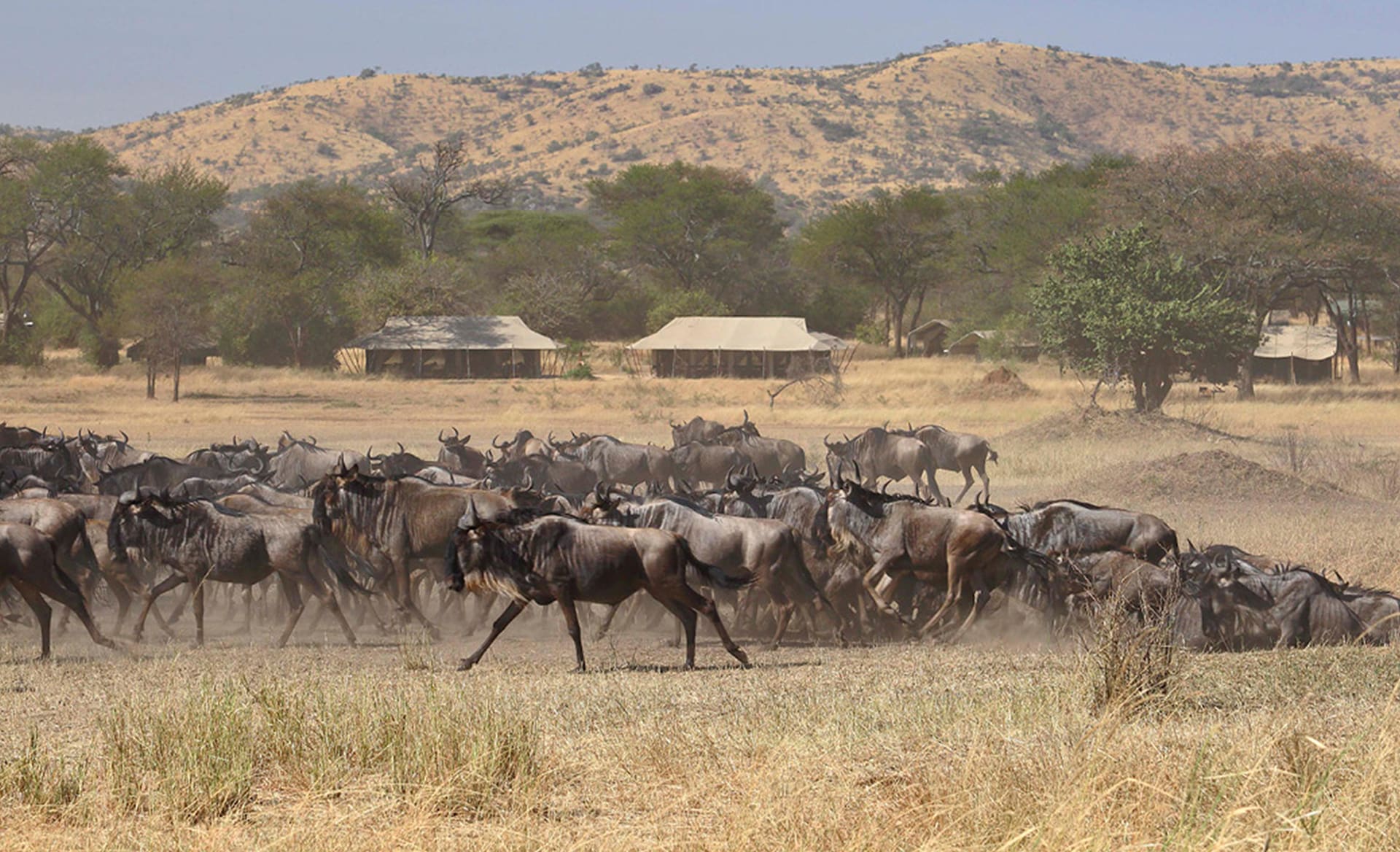
The Migration Movement updated – June 09, 2017 – We have received word from our scouts on the ground that large herds have arrived at the Sasakwa and Sabora plains. These plains are part of the Grumeti Reserves which is adjacent to the Western Corridor of the Serengeti. Bordering the national park, the reserve encompasses 340,000 acres of unrivalled wilderness. The area forms part of the famous migratory route, which is travelled by hundreds of thousands of animals every year.
The Migration Movement updated – April 15, 2017 – The herds are still in and around Lake Ndutu. If you’re planning a migration safari, it’s the best place to be at this moment in time. April is one of the most consistent times to see the herds. This is when they slowly get going as the newborn calves and foals get mobile. Don’t be scared of the long rains in April. It rains mostly in the evening and days are generally clear. The main effect of the rains, is that the plains will be wet, and the black cotton soil slippery. If you can deal with the rain and slippery roads, you’ll be rewarded with excellent sightings.
The Migration Movement updated – March 15, 2017 – Fresh reports from our guides from 13th March inform that with over two weeks of rains, the Mara grassland is beaming with fresh lush green grass and flowers blossoming. Carnivores and herbivores are happy! We have received information from Asilia´s Namiri Plains Camp, from where it seems that wildebeest are moving further south; a few wildebeest were in the area for a week ago, but they seem to be moving around heading further south of the camp, very few remaining in the area and some of the zebras.
The Migration Movement updated – February 27, 2017 – Good news today, we just had contact from our guides in Ndutu and they say it rained last night! Currently the migration is very scattered, while Ndutu woodlands are relatively green and there are some smaller herds, a lot of them are on the plains towards Kusini and Maswa, some even reaching North towards Moru, but with a couple of more showers they should all move back towards Ndutu in the next couple of days. Calving season might be going slower due to the lack of rain in the Serengeti, but in Kenya’s Olare Motorogi Conservancy, the rain over there has seen the Loita herds finally giving birth.
Ndutu Lodge Cat Round-up – Ndutu has always been great for cheetah sightings, the wide open plains making good hunting ground. Rainy season at Ndutu, when the game is prolific, should be a time of plenty for the cheetah, a time for the mothers to ensure their young off-spring get a really good start in life. The problem is, rainy season is high season too, and for tourists the highlight of a safari is seeing a cheetah hunting. Enthusiasm and often ignorance too, means that vehicles become a hindrance as they venture closer and closer or get between the cheetah and the prey – all for a better photo. The wildlife guidelines for the NCAA require that vehicles stay 25m away from wildlife, and sadly this is very rarely adhered to, and cars can often ruin the experience not only for other tourists, but also for the cheetah, who might only have that one chance that day to feed her family. Ndutu continues to delight and intrigue with changes within lion prides. Lionesses in both the Masek and Twin Hill prides have GPS collars attached now, and the information of the whereabouts of the prides daily, gives important information to the KOPELION project, and has helped to keep these lions alive through a long and extended dry period. We have seen these prides change the boundaries of their territories as they seek safety and food away from the pastoralists and their livestock. The GPS data shows the territories of these two prides continually overlap, often in the cover of darkness, and we often wonder what goes on when they actually meet. The cubs are all well grown into healthy sub-adults now, and it won’t be long until the males from these prides move off and venture out on their own. We already know that Nayomi of the Twin Hills pride has two new cubs which she expertly keeps hidden in low scrub. Katavi, the lone resident male of these two prides, continues to share himself between the two, making the most of having many lionesses to keep him well fed.
The Marsh Pride at Ndutu, which has been a solid family unit is adjusting to life without three of their main lionesses. A new era for the Marsh Pride is beginning.; Spot who was killed by two invading males, probably defending her cubs, and Notch and No Name, the eldest two lionesses of the pride, having reached a wonderful age of around 17. This has left the pride quite depleted and a little lost, as only Aphrodite is left to raise 5 cubs on her own. Cassandra with her band of 9 subadults is still very much elusive and although they come and go from the marsh, haven’t teemed up with Aphrodite again. Times change and life goes on. A new era for the Marsh Pride is beginning.
We got quite a surprise to come across Laura of the elusive Thin Pride, with her daughters Willow and Winnie, right in big Marsh last week; new territory for them too. Although they had bellies dragging on the ground they determinedly stalked and chased zebra that came down to drink, but low slung undercarriages ensured the attempt was unsuccessful. And the Greek God equivalents of the lion world, Remus and Romulus continue to reign supreme in the Marsh Areas. Remus, often staying close to the Marsh Pride, but Romulus who has a bit of a reputation of a “ne’er do well” often strays further afield.
![]()
The Migration Movement updated – December 05, 2016 – We’ve just received reports from our partners in the central Serengeti that the herds are scattered all way from Togoro Plains down to southern Seronera. There are small herds are around Moru Kopjes too. If you’re planning on seeing the migration in December with a last-minute safari, then it’s best to stay southof Lobo, especially if there’s been a decent amount of rain in the northern Serengeti.
The Migration Movement updated – November 05, 2016 – 30,000 wildebeest crossed the Mara River at crossing point four from the Serengeti National Park, Tanzania, back towards the Kenyan side on 3 November 2016. They are all over the place these days. Scattered herds are seen in the North near Kogatende and Lamai and some herds as far south as Seronera and west as the Grumeti.
The Migration Movement updated – September 12, 2016 – Even more fascinating is that they were crossing from the Mara Triangle (South west) into the reserve heading towards Mara North, Olare Orok and Naboisho Conservancies! This just means we still have a chance to enjoy the migration for few coming weeks.
The Migration Movement updated – September 05, 2016 – Late last week, Asilia Africa Rekero Camp guide Onesmus Irungu informed us that the Mara River crossings were still happening at Cul de Sac crossing point. The herds were moving from the Reserve to the Mara Triangle Conservancy, meanwhile, hundreds of thousands of the migrating herd are still stuck at Mara Triangle enjoying the short grass plains. On the Serengeti side, the herds are gathering at crossing point number six, with the majority of the herds situated around the Wogakuria area.
The Migration Movement updated – August 29, 2016 – Early last week, we received reports of the herds crossing the Mara River at a place known as the ‘deadly crossing point’. The herds were forced to cross by a lioness who charged the wildebeest, splitting the herds up in two.September is your last chance to see the epic Mara River crossings in the Serengeti or Masai Mara.The last of the herds are crossing the Mara River but most of the wildebeest can be found in the Greater Masai Mara area. The wildebeest will eat all the lush green grass and start moving north again.
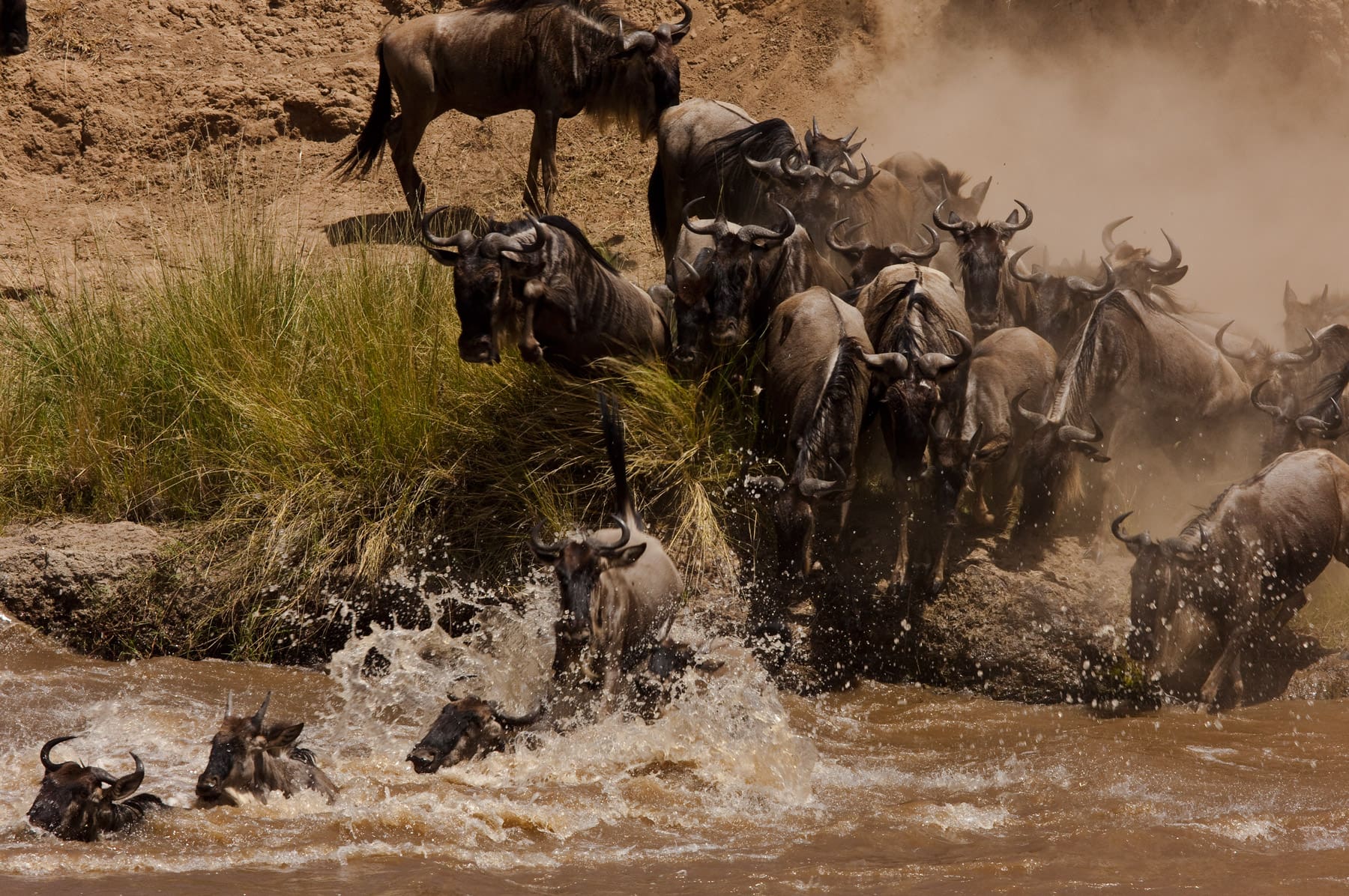
The Migration Movement updated – August 22, 2016 – On the Serengeti side of the Mara River, we received reports of crossings happening at crossing point 2 and 4, with the migratory herds moving back and forth from north to south. Meanwhile at the Mara River’s main crossing point in Kenya’s Masai Mara, Kenya safari guide, crossings are still underway. Kenya safari guide Timothy Leperes Laur sent us these dramatic images of the herds crossing the Mara River.
The Migration Movement updated – August 15, 2016 – Late last week, we received reports of a massive crossing at the 10,000 wildebeest cross the Mara River – heading towards Bila Shaka. They had come from the east marsh areas and were headed straight to the south bank of the Bila Shaka and joined up with an equally large herd. The crossings are set to continue over the course of the next week, as the wildebeest herds continue their search for lush, greener grass and by doing so, attempt to cross the dangerous, crocodile infested water of the Mara River.
The Migration Movement updated – July 22, 2016 – Big herds have moved north with the majority located between Kogatende and Lobo in the Serengeti. Meanwhile, late last week reports from Rekero Camp were that the wildebeest herds were crossing the Mara River at the Lookout Hill crossing point. Yesterday afternoon, large herds of wildebeest and zebra both resident and migratory had moved from the Topi Plains and Malima Tatu areas and into the East Marsh, Bila Shaka and Musiara grasslands. Governors Camps reported yesterday evening, a large crossing of wildebeest and zebra were seen going from west to east at the main crossing point, four wildebeest were taken by the resident crocodile, one yearling wildebeest that was caught by a crocodile struggled and kicked, it was able to get away with the crocodile only on its tail.
The Migration Movement updated – February 29, 2016 – The migration is around Kakesio and the Makao plains right now. Lots of of newborns witnessed. There are huge herds of wildebeest still around Kimuma Hill and across to Ubuntu and Ndutu. North of there on the plains towards It’s still sunny and dry here and plenty of green grass so hopefully they will be around here for a bit longer!
The Migration Movement updated – February 01, 2016 – Rain on the plains: The New Year started for our grunting gnu’s with a rather prolonged dry spell which persisted through most of January, and that meant that the bulk of the migration herds moved towards Kusini and Maswa. However, reports from our guides in the Serengeti is that it has now started raining again, and the southern plains are full of wildebeest. The herds are spreading from Piyaya, Barafu, Golini and over the triangle between Naabi and Ndutu, through to the Ndutu marsh, Matiti and all the way out towards Kusini. It really is an incredible scene out there, check out these pics taken by our guide Ian Kiwelu. It is raining almost daily at the moment, which does make game drives in some areas a little interesting, but it has brought the wildebeest back to where they should be – happy days.


